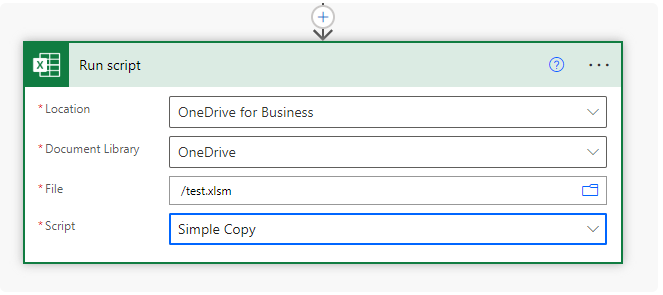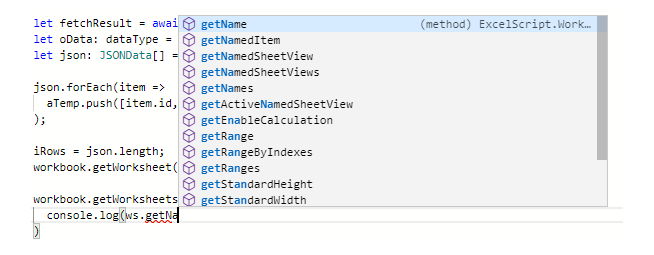Power Automate Office Scripts Basics
<slideshow style="nobleprog" headingmark="⌘" incmark="…" scaled="true" font="Trebuchet MS" >
- title
- Power Automate Office Scripts Basics
- author
- Lukasz Sokolowski
</slideshow>
Power Automate Office Scripts Basics
Power Automate Office Scripts Basics Training Materials
Copyright Notice
Copyright © 2004-2025 by NobleProg Limited All rights reserved.
This publication is protected by copyright, and permission must be obtained from the publisher prior to any prohibited reproduction, storage in a retrieval system, or transmission in any form or by any means, electronic, mechanical, photocopying, recording, or likewise.
Agenda
Single module context
- Accessing Scripts
- Triggering Scripts in Power Automate
- IntelliSense
- Variables, Types and Interfaces
- If
- Loop
- Get & Set
- Basic Excel Actions
- Send and Return Data
- Additional functions
Introduction
Office Scripts
- Online version of VBA
- Built to run in Excel online
- similar to GoogleDocs App Scripts, but based on TypeScript instead of Javascript
- TS is a subset of JS, so we can use JS as well
- More here
Accessing Scripts
In Excel online (Business version only)
- an Automate tab in the ribbon bar
- the Ribbon allows to record actions (just like vba)
- Create a blank New Script
- Open existing Scripts
- and Automate a Task with a Power Automate template
- The Record function
- does not record every action
- uses selections instead of references
- does show good notes and is a good way to learn
Triggering Scripts in Power Automate
Office Scripts
- can be run by adding the Run script action under Excel Online (Business)
- More here (connector docs)
- by default stored on our OneDrive (Documents/Office Scripts folder)
- can be shared with a file by clicking Share (same menu as adding a button)
- this attaches the script to the file, so anyone with the file can run the script
- unfortunately shared scripts can not be called by Power Automate
- it can only call scripts stored on the connected OneDrive account
IntelliSense
Intellisense
- auto complete for code
- we type in the function we want
- Office Scripts will try and guess what we're typing by listing all possible options
- speeding up our typing
- can be used as a reference to find the function we're looking for
Variables, Types and Interfaces
Basic TypeScript knowledge is required
- variables are declared with let or const
- need to declare type (must have value set against them)
let sString = "";
let iNumber = 0;
let bFlag = false;
- we declare objects like: workbooks, worksheets, images, ranges and more to variables
- make them easier to use and update
function main(workbook: ExcelScript.Workbook) {
let ws = workbook.getWorksheet("Sheet1");
ws.setName("test");
}
- variables are scoped locally
- declared in the function/loop is scoped to that function/loop only
- can't be read outside of it
Arrays, interfaces
2 options, an empty array and structured one
- Empty arrays - for simple arrays with no objects within them
- If we need an object - we should use an interface to set the structure
function main(workbook: ExcelScript.Workbooklet){
let aSimple = []; // [10, 20, 30, 40, 50]
let aStructured: Schema[];
/* [ { stringField:"test", numberField:1, booleanField: false }
, { stringField:"test2", numberField:2, booleanField:true } ] */
}
interface Schema {
stringField: string,
numberField: number,
booleanField: boolean
}
Types vs Interfaces
type is for an object
- for structuring an object we're about to add to an array
- usually is also called outside of the function
- similar to an interface, but less general
- interface - reusable but generic, usually outlives the module
- type - reusable but more specific, usually stays within the module
type dataType = {
data: JSONData[]
}
If
Fundamental action
- Office Scripts leverage TypeScript/JavaScript
- Example
if( rng[i][0] == 7 ){
aNewRange.push( rng[i] );
} else {
console.log( "Not a 7" );
}
Loop
Get & Set
.getWorkSheet("Sheet1")
- get is used to reference something
- to either store as variable or to complete an action against e.g. setValue()
- it can get not only parts of the workbook, but parameters to them, like worksheet name
- we get our worksheet, get our range, then we set our range
- that can be a formula (setFormula) or value (setValue)
- can be one cell or a range (setValues)
Example
- Copying a filtered list from one sheet to another
// First thought - the best approach would be to filter the excel data, then copy and paste
//// Better is to grab the whole range, filter it, then paste and set the range to the filtered values
// We could also set the range 'row by row' in the loop
//// - but this can have a big impact on performance
//// - for any interactions with the Excel, file uses api calls
//// - we should avoid placing them in loops where ever possible
function main(workbook: ExcelScript.Workbook) {
let ws = workbook.getWorksheet( "summary" );
let i = 0;
let aNewRange = [];
let rng = ws.getUsedRange().getValues(); // gets values from range
aNewRange.push( rng[0] ); // adds header row
for( i == 0; i < rng.length; i++ ){ // loops over rows in the array
if( rng[i][0]==3 ){ // if condition
aNewRange.push( rng[i] ); // adds row to array
}
}
// sets array to range
workbook.getWorksheet( "Sheet2" )
.getRange( "A1:e"+aNewRange.length )
.setValues( aNewRange );
}



